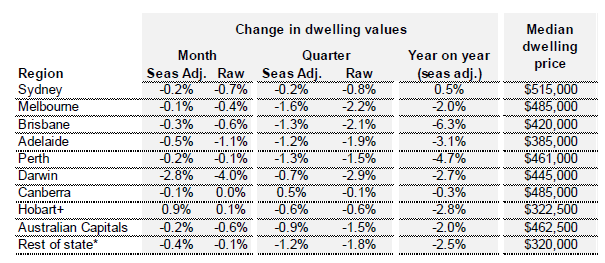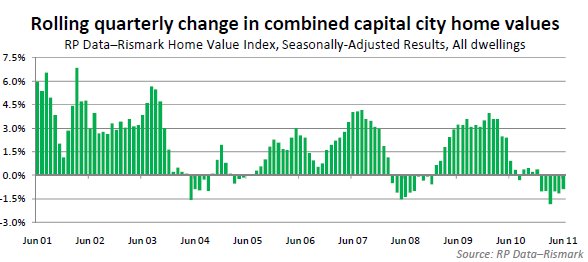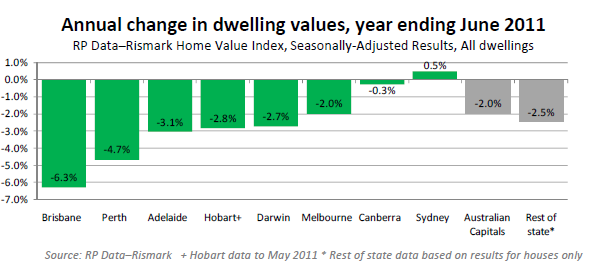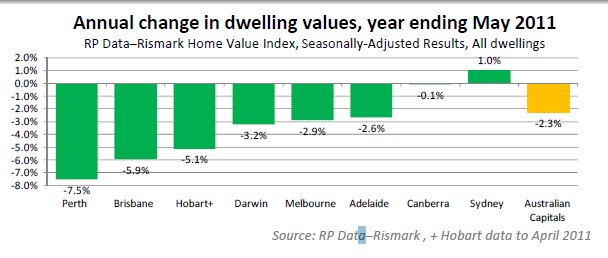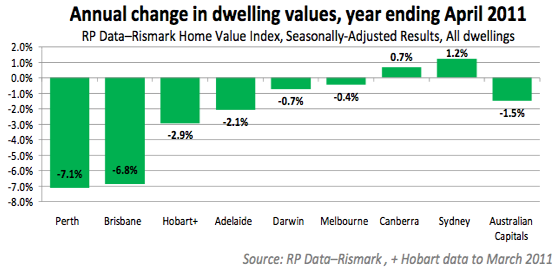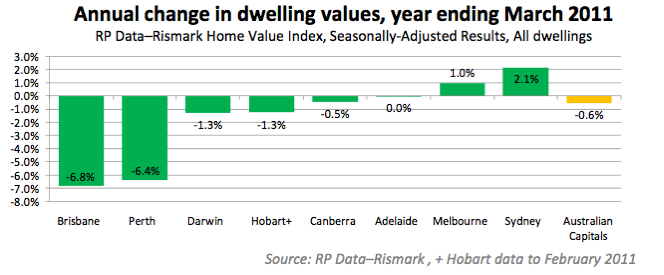As Data sword stated earlier today the latest RPData media release is out today. As per usual I like to look beyond the headlines.
Across the combined capital city housing markets, the rate of home value declines continued to moderate with values in June falling 0.2% in seasonally adjusted (s.a.) terms. The relatively flat June result follows month-on-month drops of 0.3% in May, 0.4% in April and 0.5% in March (s.a.).
Based on almost 150,000 home sales nationally over 2011, the market-leading RP Data-Rismark Hedonic Home Value Indices showed a seasonally-adjusted fall of -0.2 per cent in capital city home values over the month of June (-0.6 per cent in raw terms)
While the June result was technically the sixth straight monthly correction in capital city home values, the rate of decline has been moderating since January when capital city values fell by 1.2 per cent (s.a.) over that month alone due to the natural disasters along the east coast of Australia.
Over the June quarter capital city home values were down by 0.9 per cent on a seasonally-adjusted basis (-1.5 per cent raw). The year-on-year results show capital city home values off 2.0 per cent, which is a slight improvement on the 2.2 per cent fall last month based on revised figures (was -2.3 per cent).
The modest overall decline in national dwelling values conceals considerable variation across the capital cities. For example, whereas Brisbane and Perth home values are down 6.3 per cent and 4.7 per cent, respectively, over the last twelve months, property values in Sydney are up 0.5 per cent.
It looks as though my complaining has paid off because I am happy to report that the long term chart has made a reappearance giving us better view of where we are in terms of trend.
And now the annual change chart for June with a couple of previous versions for your reference:
I think the data speaks for itself. The market continues to slide slowly downwards due to the low rate of new credit being issued by the banking sector. If that rate does not change then it is to be expected that the slide in houses will continue. I think the rate of that slide is likely to continue to be slow, but at the back of my mind I do worry about some sort of Minsky moment when vendors suddenly capitulate en masse. My post on Brisbane this morning shows that some vendors are taking significant losses on recent sales and the longer the slide continues the worse sentiment will become. I am concerned that there will come a time when the market will suddenly shoot downwards, but obviously that is an opinion based on my own experiences of human nature and not something empirical.
In my mind the big question is what do RPData expect to happen to credit issuance in the near future, given that it is the primary driver for housing prices and the only thing apart from as sudden surge in foreign property investment that will arrest the fall in prices. The two RPData commentators had this to say.
“Market conditions are clearly being dampened by low levels of consumer confidence fuelled by interest rate speculation and global economic jitters. The higher-than-expected CPI figures earlier this week are likely to reignite the interest rate debate which is not going to assist with an improvement in consumer sentiment,” Mr Lawless said.
Rismark’s economist, Joye, added, “I think the RBA is likely to raise rates at least once or twice more to address Australia’s burgeoning inflation problem, which means dwelling values will probably soften a bit further. This should open up attractive investment opportunities.”
Those statements certainly suggest to me that both Mr Joye and Mr Lawless expect credit issuance to slow further, even if Mr Joye is still trying to put a bullish slant on that fact. Mr Lawless actually went even further today on the RPData blog.
With Australian consumers focusing on saving and paying down debt, the prospect of higher interest rates isn’t likely to see any marked improvement in transaction volumes until we start to see a material improvement in levels of consumer confidence. Of course, the housing market is no longer high on the RBA’s list of priorities like it was back in 2009.
Inflation is firmly in the cross hairs and interest rates are likely to rise to the detriment of key sectors across the economy including retail markets, lifestyle and tourism and of course housing and finance.
That certainly reads to me like an admission that we are not going to see a sudden re-surgence in credit issuance because the RBA will not support a re-stimulation of the market as they did in 2008. This is an extremely bearish statement from Mr Lawless and quite a surprise to this blogger. One of the cornerstones of many bullish housing investors arguments is that “the government will save them if they get into trouble”. Mr Lawless seems to be suggesting that this time that will not be occurring.
Whether that is true or not is yet to be seen. Today’s credit aggregates are very worrying. As I mentioned in the comments in that post a quick analysis of monthly credit (Column L in this RBA spreadsheet) should have you concerned if you remember what happenned in both 2008 and 1991 in Australia.
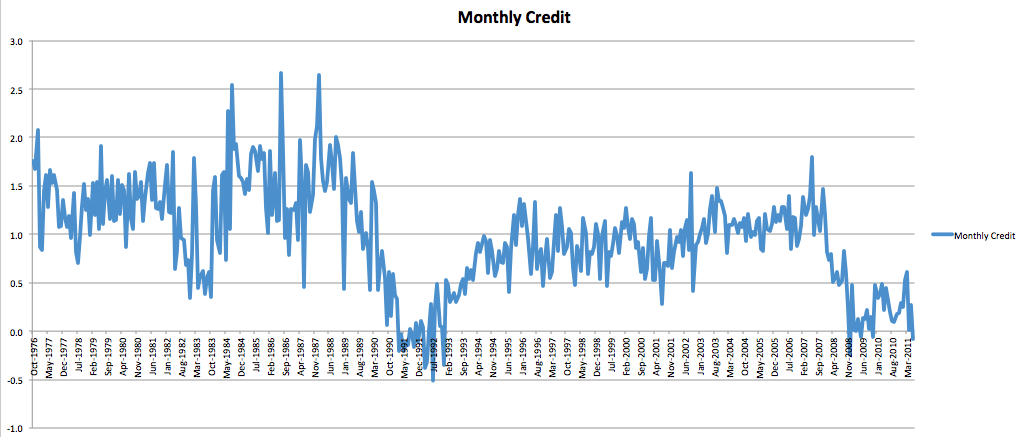
The credit data suggests that the economy is about to stall into recession and if that does happen it is difficult to determine what the RBA’s or the government’s response will be…. and even harder to determine exactly what that will mean for credit issuance rates.
